
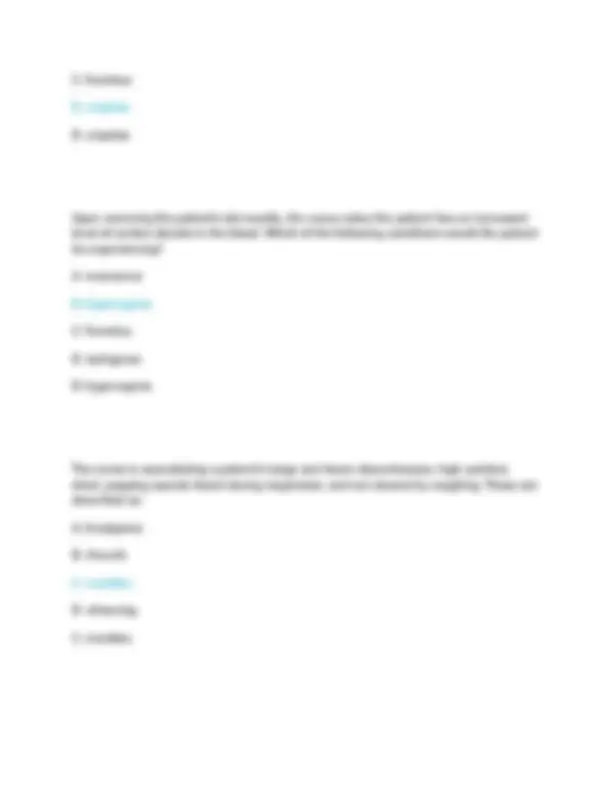
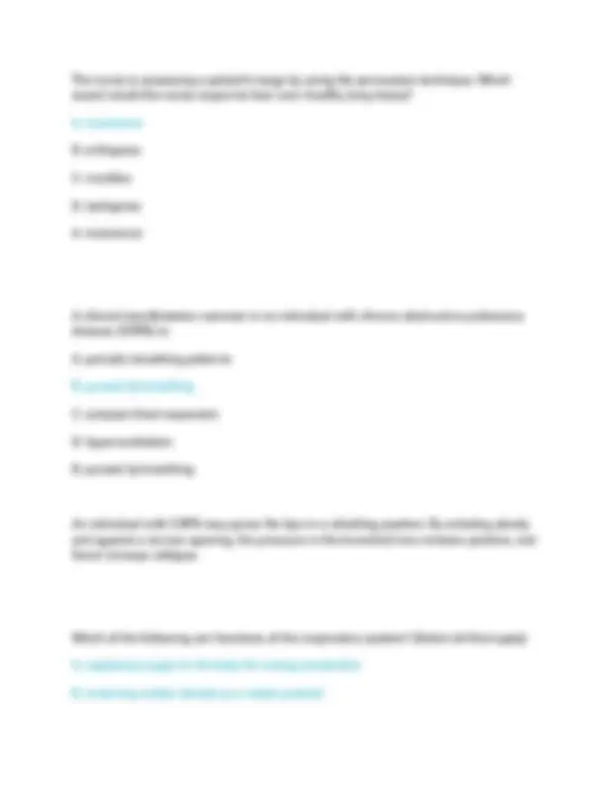
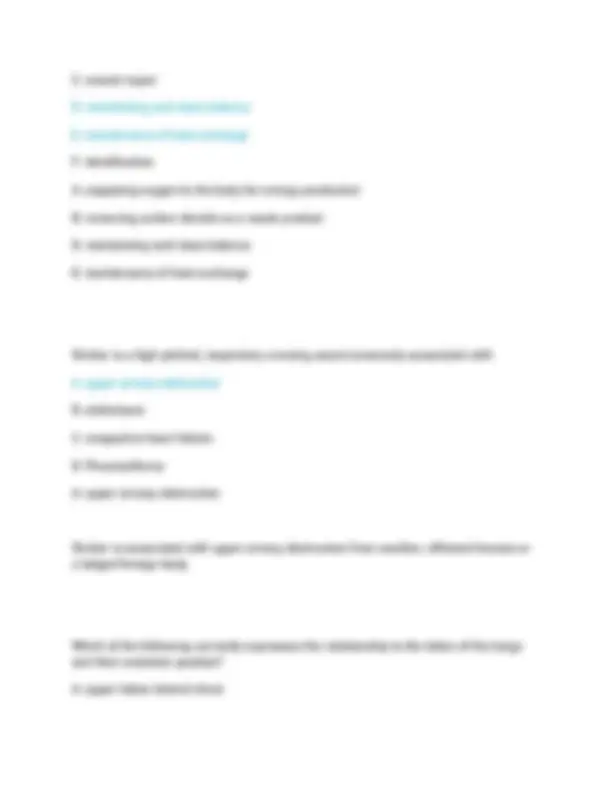
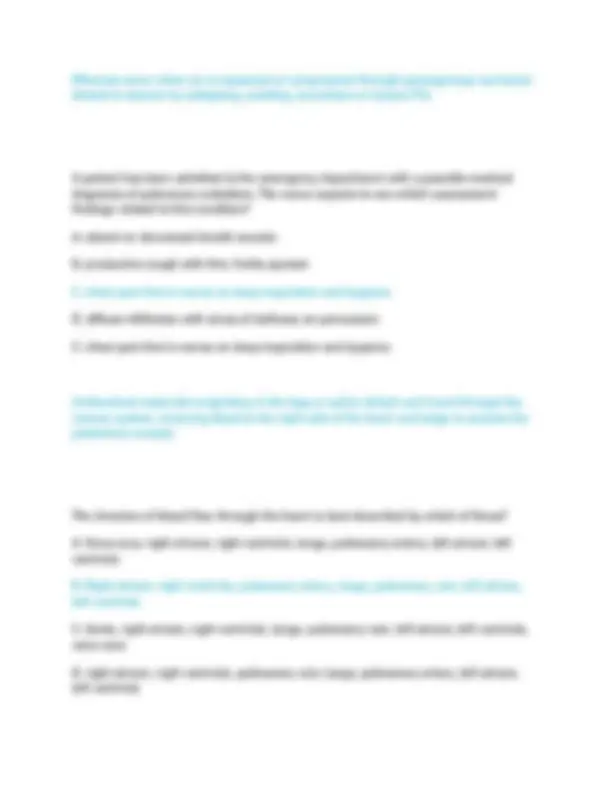

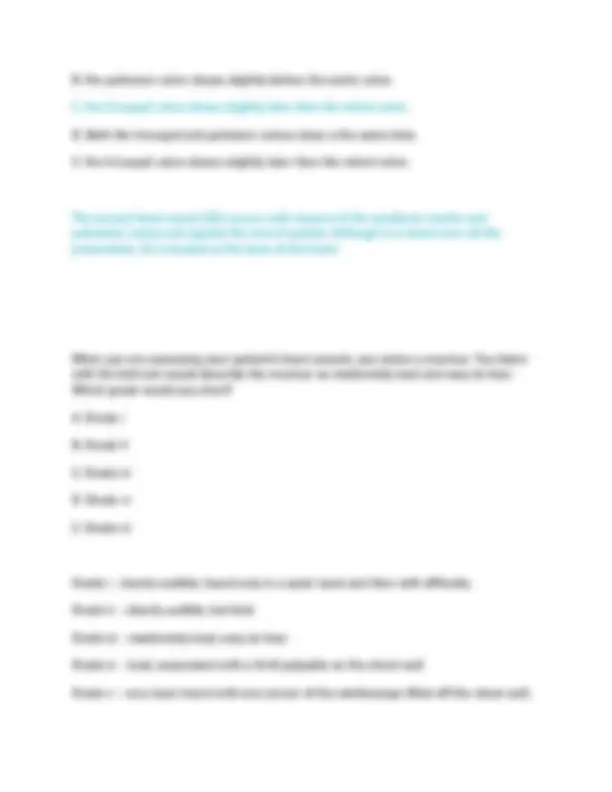
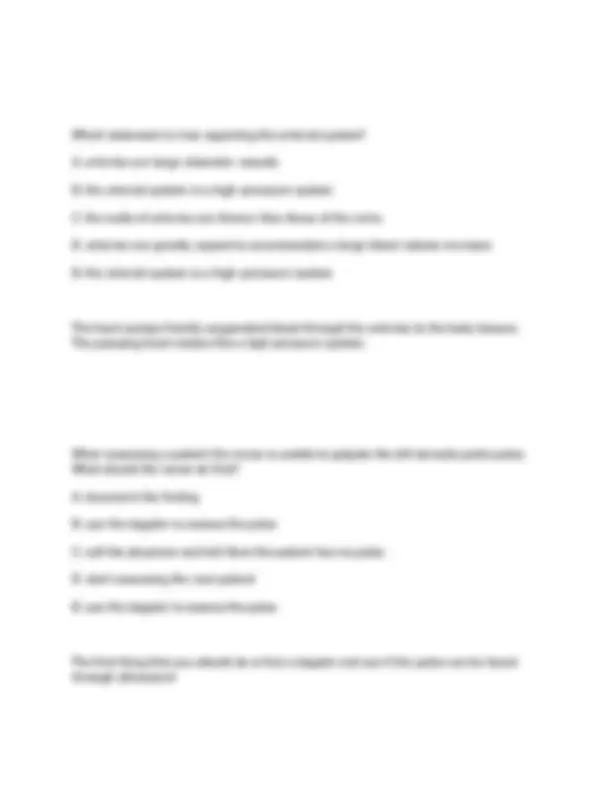
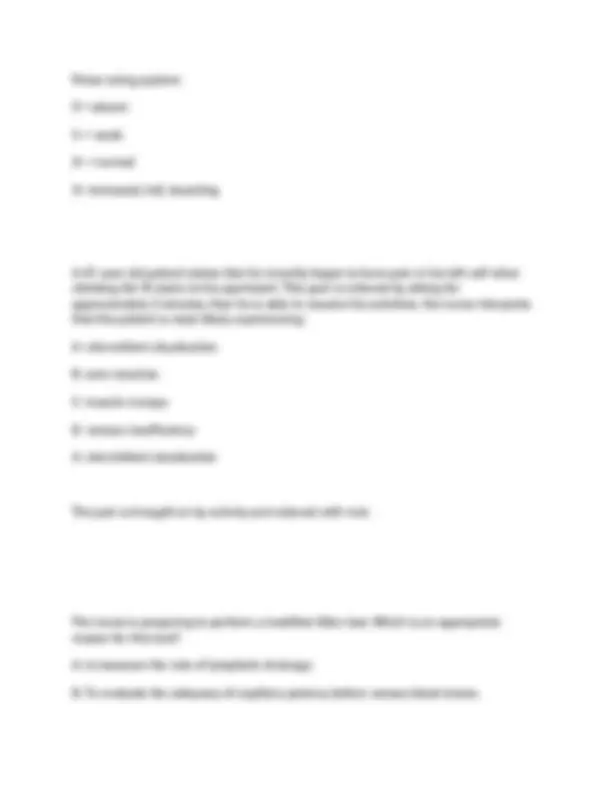
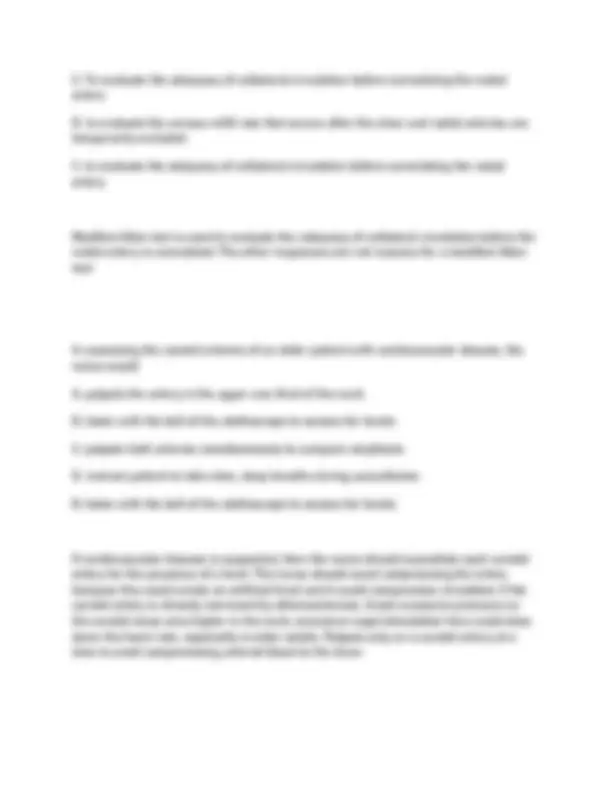
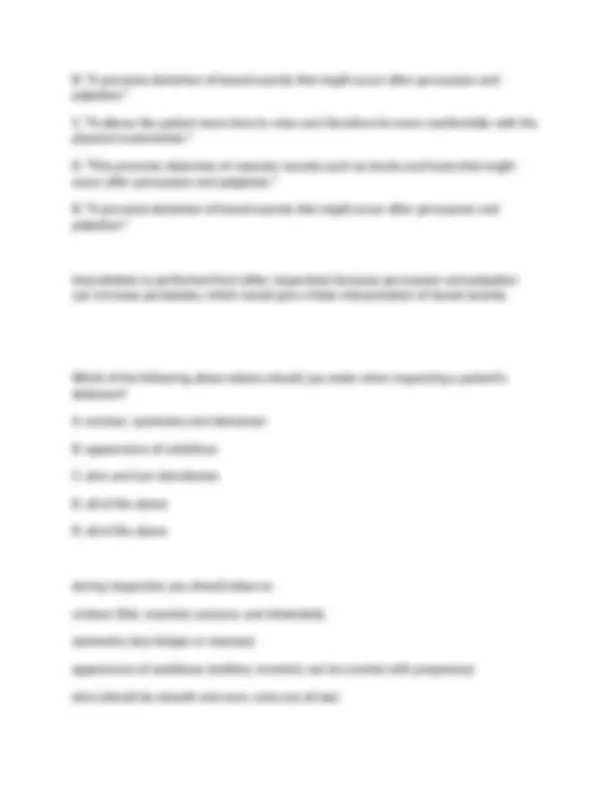
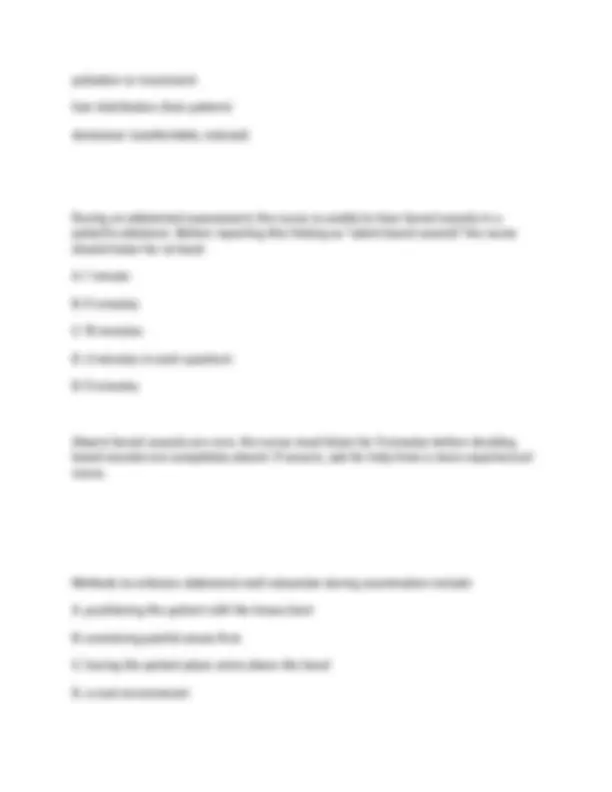

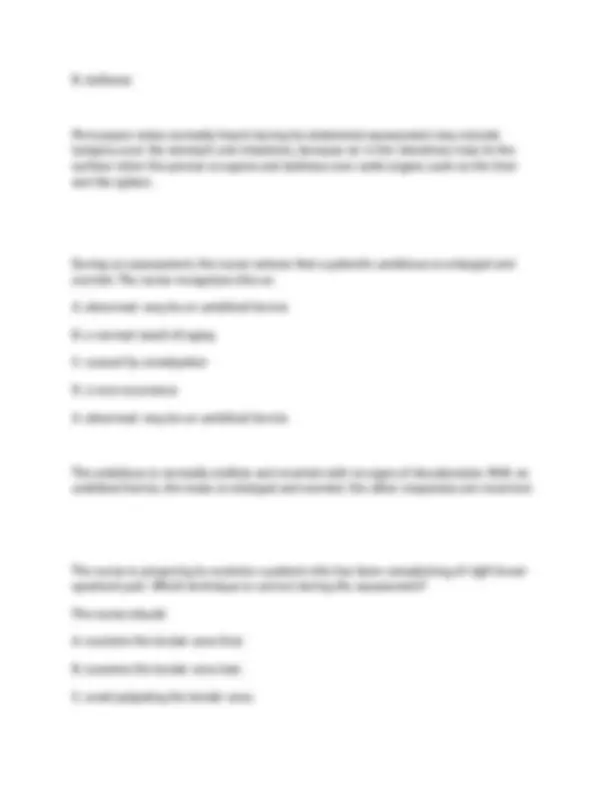
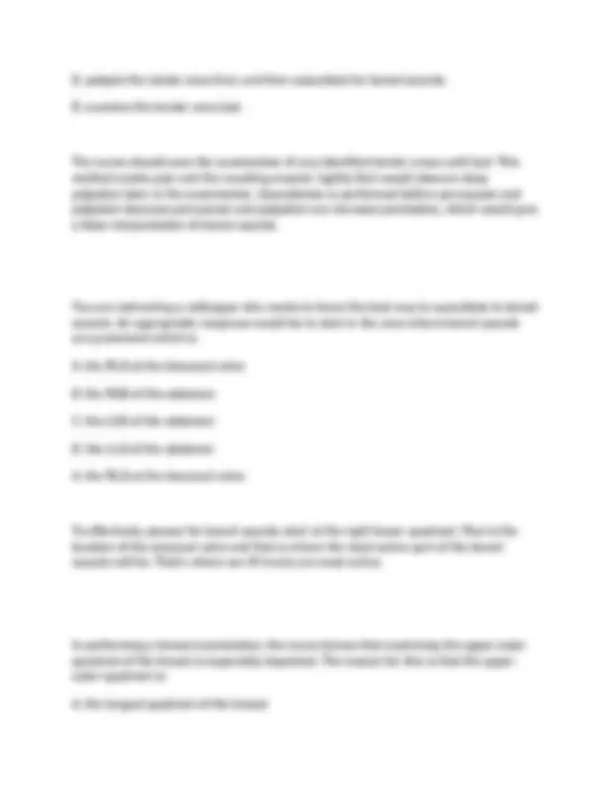
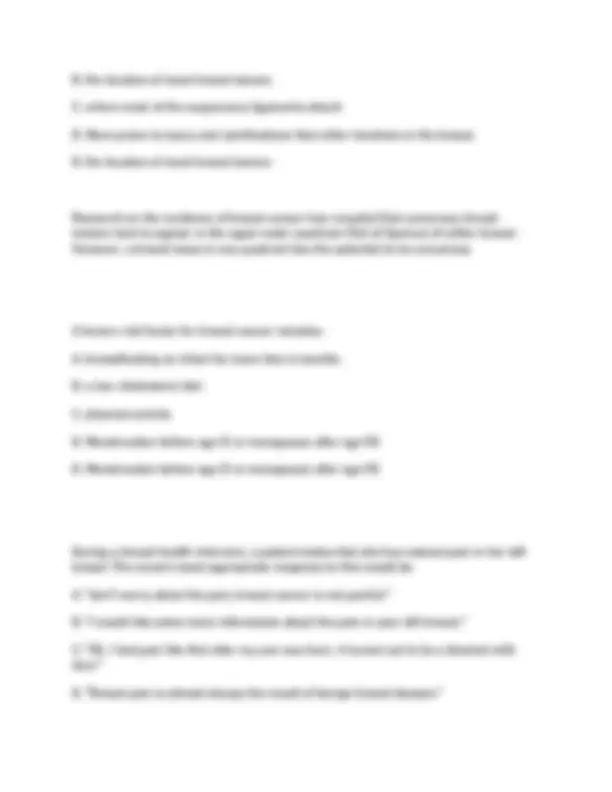
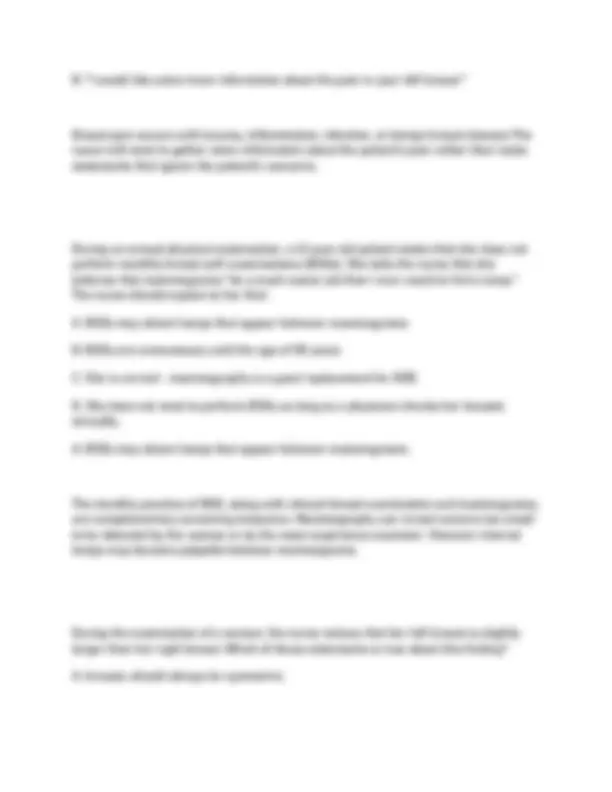
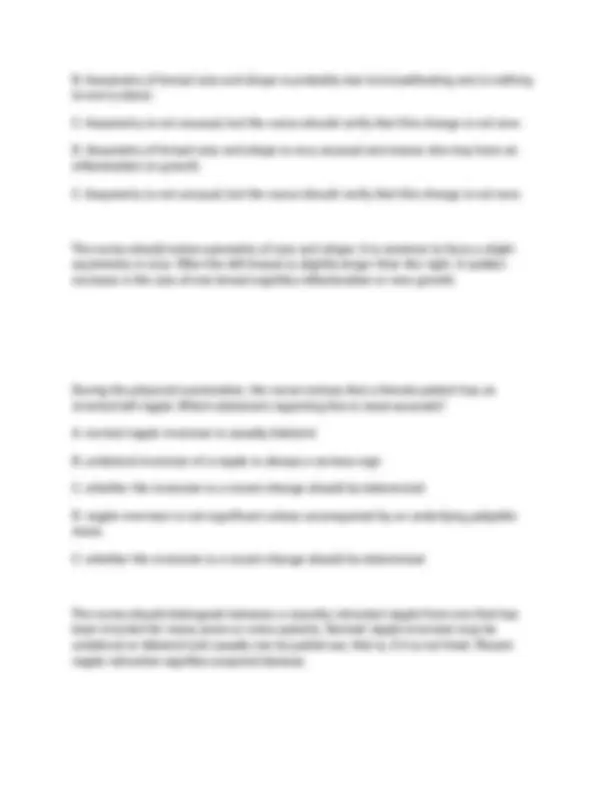
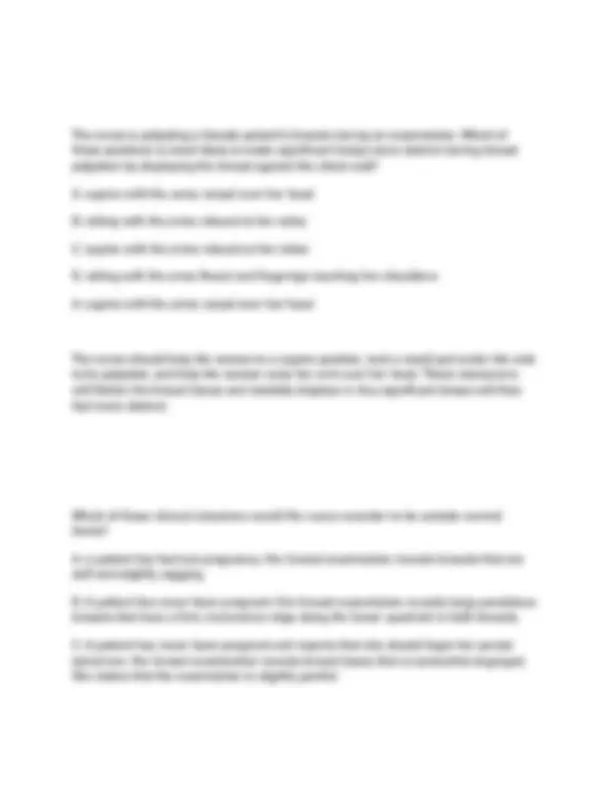
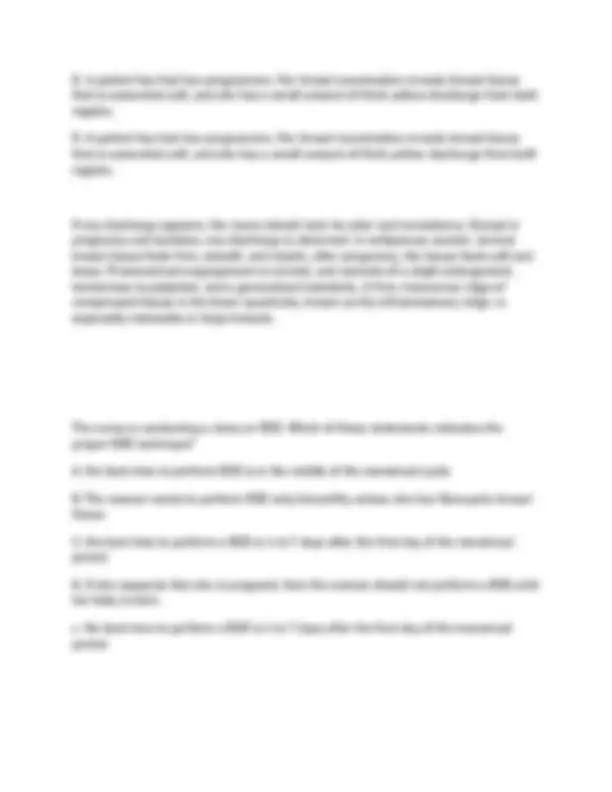
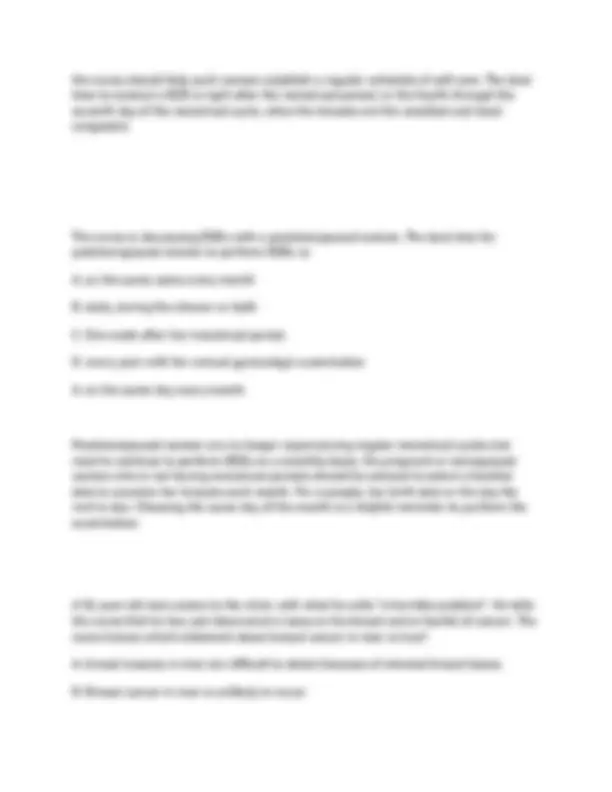
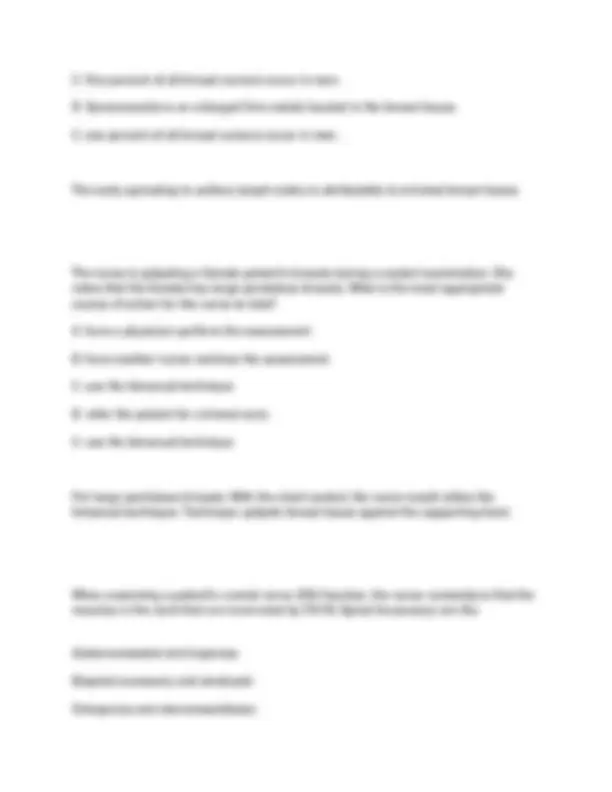
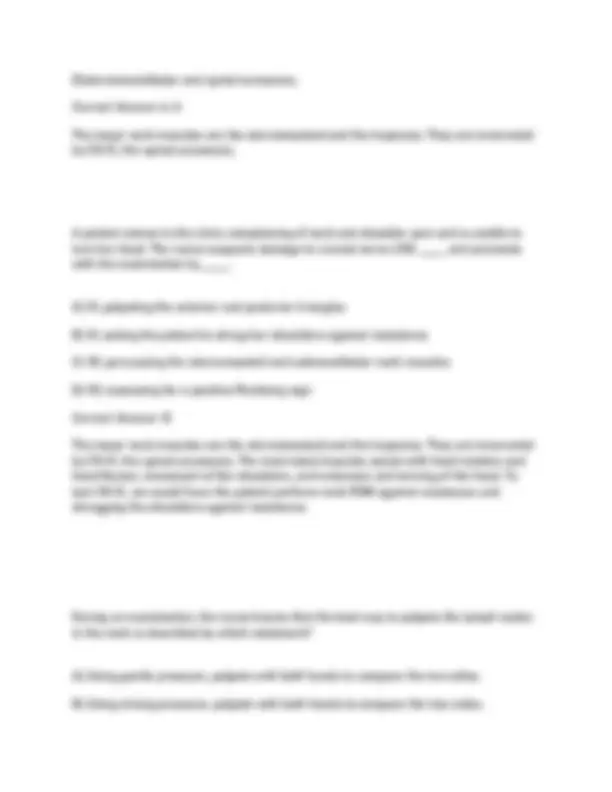
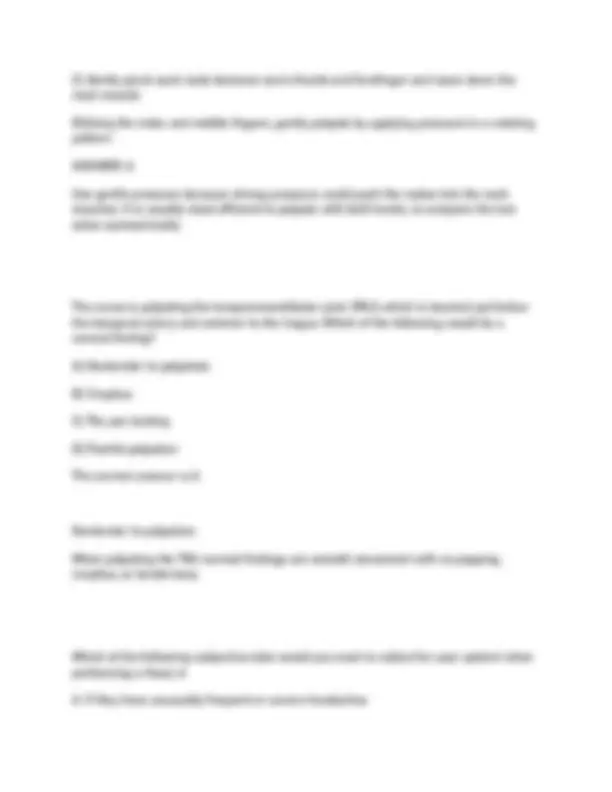
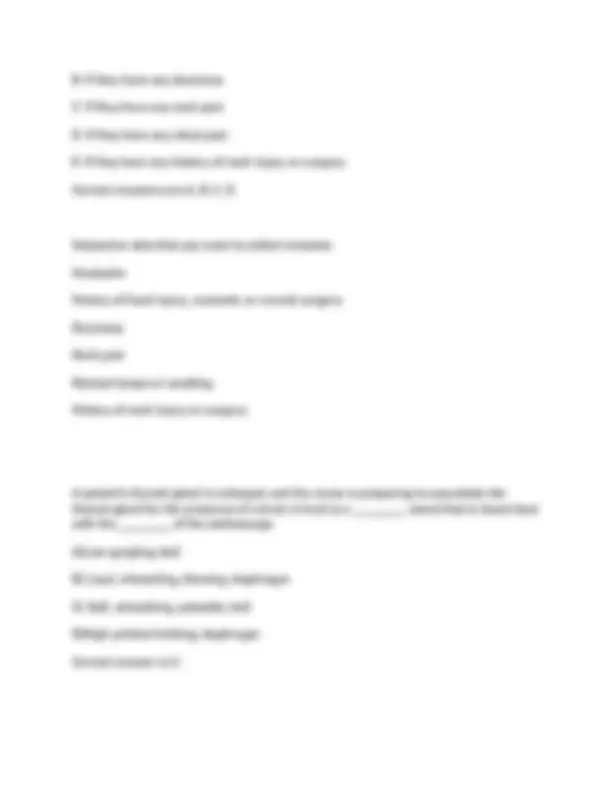
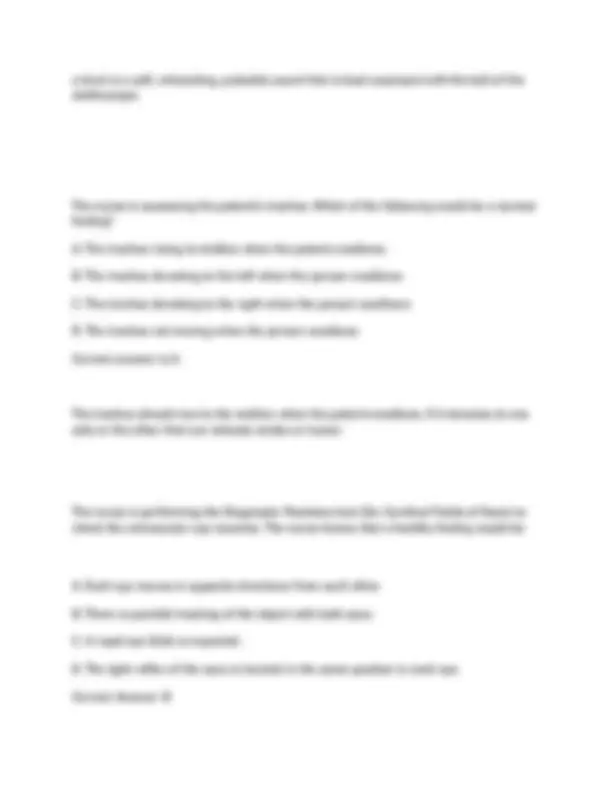
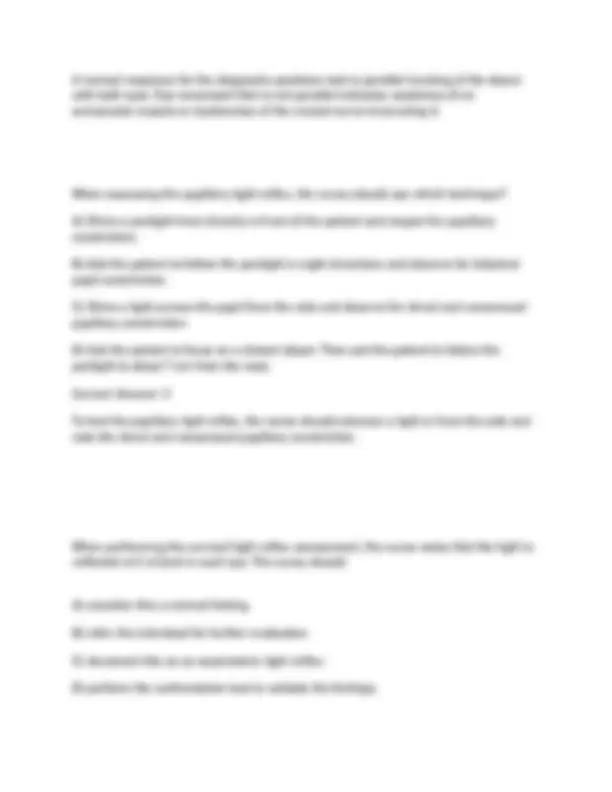
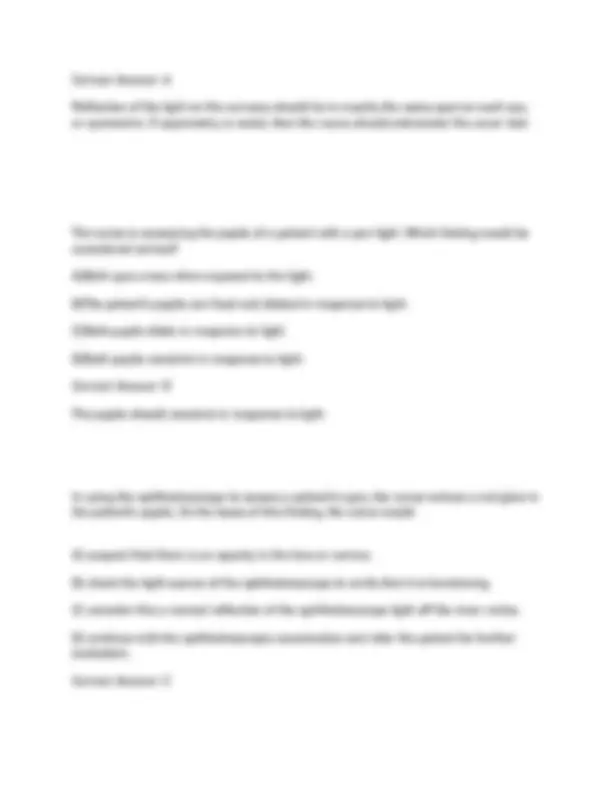
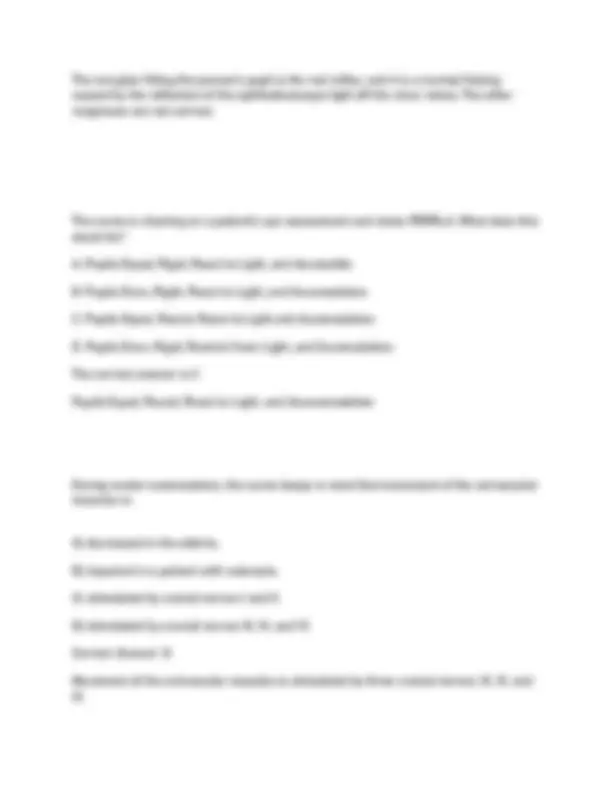
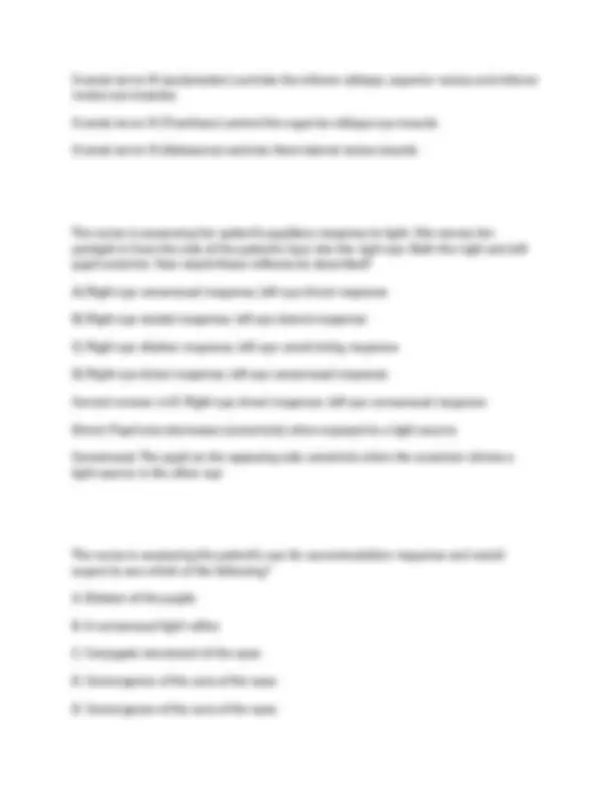
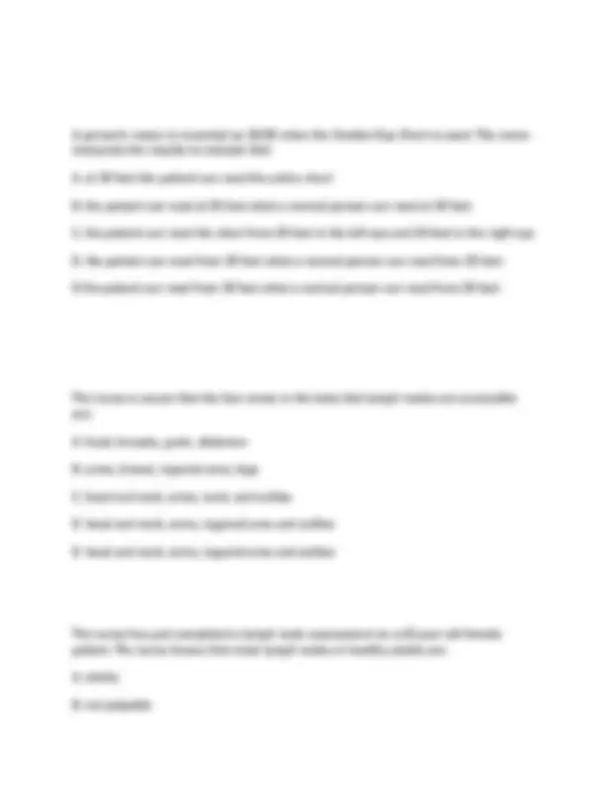
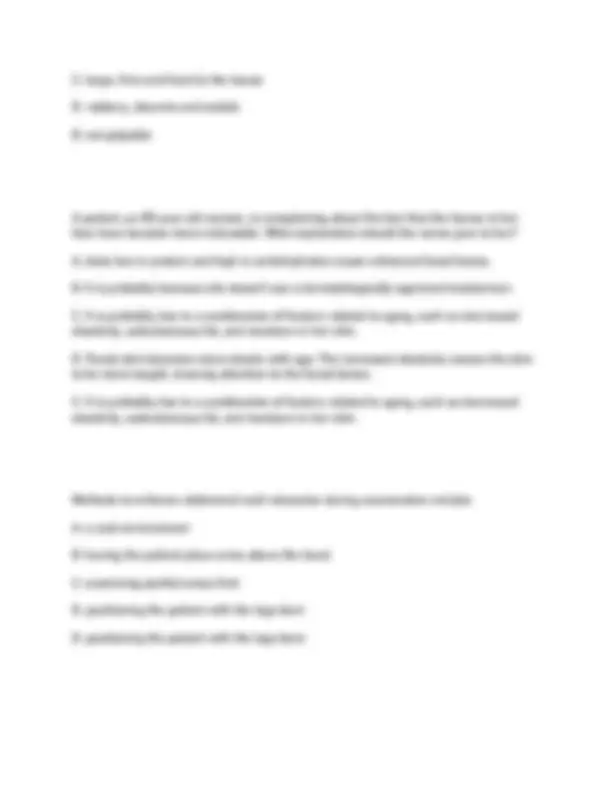
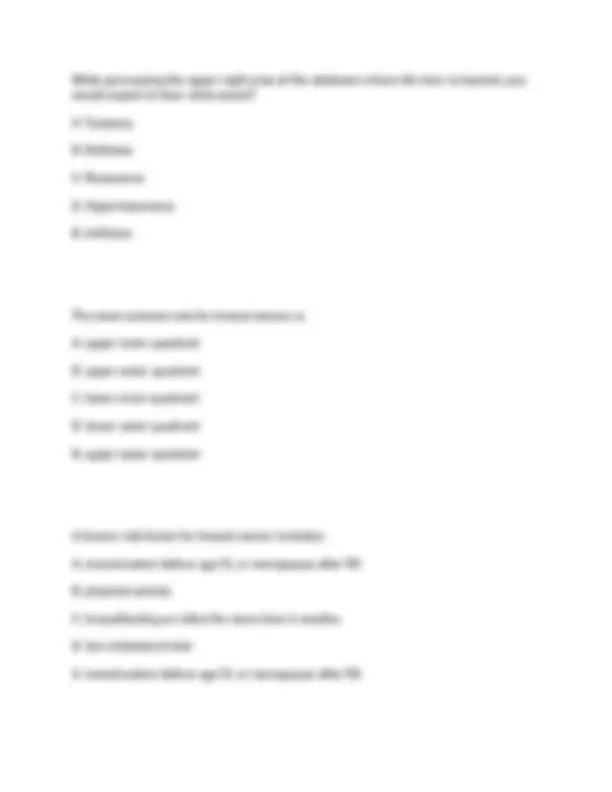
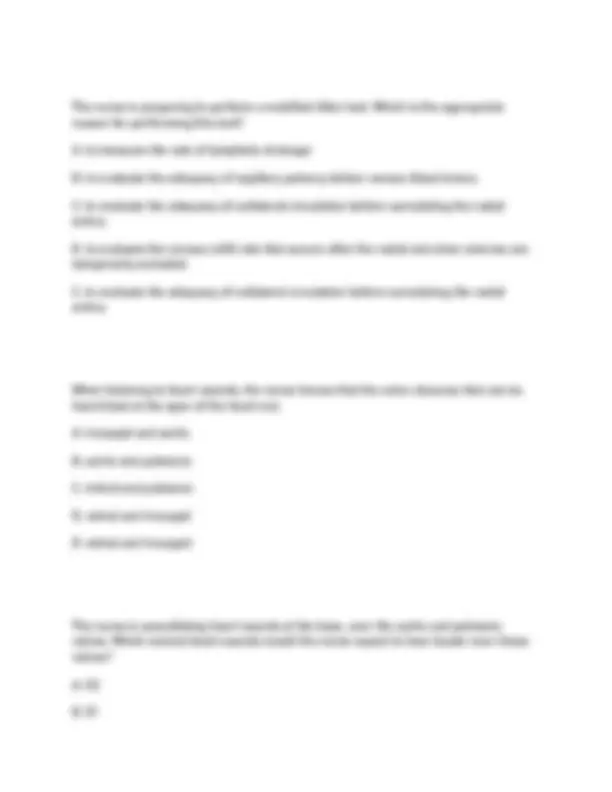
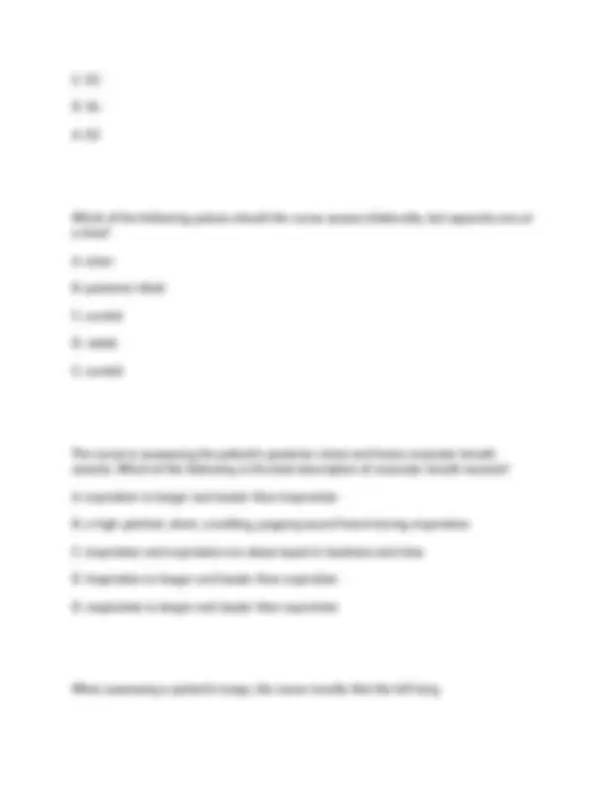
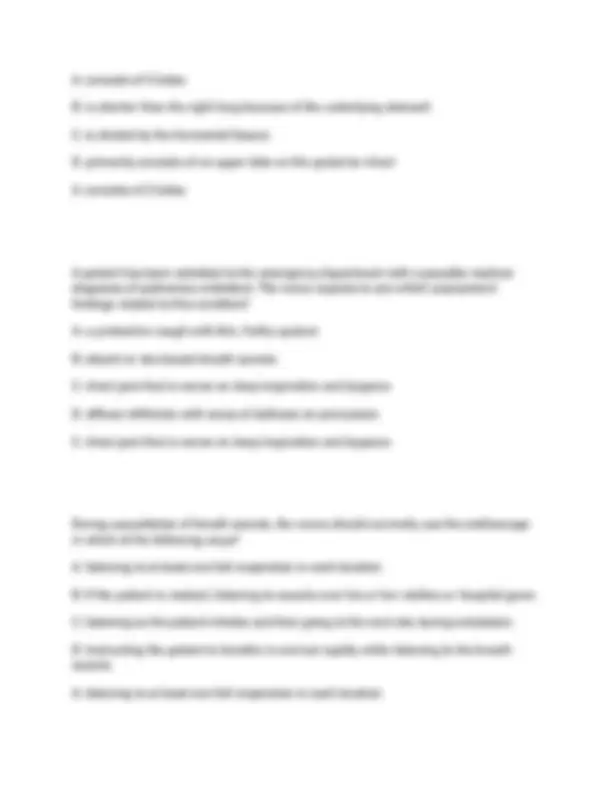


Study with the several resources on Docsity

Earn points by helping other students or get them with a premium plan


Prepare for your exams
Study with the several resources on Docsity

Earn points to download
Earn points by helping other students or get them with a premium plan
Community
Ask the community for help and clear up your study doubts
Discover the best universities in your country according to Docsity users
Free resources
Download our free guides on studying techniques, anxiety management strategies, and thesis advice from Docsity tutors
NUR 3094C Health Assessment 2025-2026 Exam 2 Review Questions with Verified and Correct Answers Guaranteed Pass (Score A) Florida State College
Typology: Exams
1 / 43

This page cannot be seen from the preview
Don't miss anything!




































A palpable vibration increased with lobar pneumonia is also known as: A. Rhonchi B. Resonance C. Fremitus D. Crackles C. Fremitus (key term is "palpable" Your patient is exhibiting rapid shallow breathing, with a respiratory rate > respirations per minute. Which of the following conditions are they experiencing? A. hypoxemia B. tachypnea C. fremitus D. resonance B. tachypnea
Increased tactile fremitus would be evident in an individual who has which of the following conditions? A. emphysema B. pneumonia C. crepitus D. pneumothorax B. pneumonia Fremitus is a palpable vibration. Increased fremitus occurs with compression or consolidation of lung tissue (ex. lobar pneumonia) Which of the following terms is used to describe a decreased level of oxygen (O2) in the blood? A. anemia B. hypercapnia C. hypoxemia D. emphysema C. hypoxemia The nurse is assessing a patient who has emphysema. They note a course, crackling sensation that is palpable over the skin surface. This is known as: A. hypoxemia b. crackles
The nurse is assessing a patient's lungs by using the percussion technique. Which sound would the nurse expect to hear over healthy lung tissue? A. resonance B. orthopnea C. crackles D. tachypnea A. resonance A clinical manifestation common in an individual with chronic obstructive pulmonary disease (COPD) is: A. periodic breathing patterns B. pursed lip breathing C. unequal chest expansion D. hyperventilation B. pursed lip breathing An individual with COPD may purse the lips in a whistling position. By exhaling slowly and against a narrow opening, the pressure in the bronchial tree remains positive, and fewer airways collapse. Which of the following are functions of the respiratory system? (Select all that apply) A. supplying oxygen to the body for energy production B. removing carbon dioxide as a waste product
C. wound repair D. maintaining acid-base balance E. maintenance of heat exchange F. identification A. supplying oxygen to the body for energy production B. removing carbon dioxide as a waste product D. maintaining acid-base balance E. maintenance of heat exchange Stridor is a high pitched, inspiratory crowing sound commonly associated with: A. upper airway obstruction B. atelectasis C. congestive heart failure D. Pneumothorax A. upper airway obstruction Stridor is associated with upper airway obstruction from swollen, inflamed tissues or a lodged foreign body. Which of the following correctly expresses the relationship to the lobes of the lungs and their anatomic position? A. upper lobes-lateral chest
Causes significant back pain and limited mobility. It is associated with aging, and people with adequate exercise habits are less likely to have kyphosis. Scoliosis is S shaped curvature of the spine Barrel chest is equal AP to transverse diameter and is associated with aging and chronic emphysema or asthma. Pectus excavatum is a markedly sunken sternum and adjacent cartilages that is congenital. The nurse is observing the auscultation technique of another nurse. The correct method to use when progressing from one auscultatory site on the thorax to another is ___________________ comparison. A. side-to-side B. top-to-bottom C. posterior-to-anterior D. interspace by interspace A. side to side The nurse is listening to the breath sounds of a patient with severe asthma. Air passing through narrowed bronchioles would produce which of these adventitious sounds? A. wheezes B. bronchial sounds C. bronchophony D. crackles A. wheezes
Wheezes occur when air is squeezed or compressed through passageways narrowed almost to closure by collapsing, swelling, secretions or tumors.The A patient has been admitted to the emergency department with a possible medical diagnosis of pulmonary embolism. The nurse expects to see which assessment findings related to this condition? A. absent or decreased breath sounds B. productive cough with thin, frothy sputum C. chest pain that is worse on deep inspiration and dyspnea D. diffuse infiltrates with areas of dullness on percussion C. chest pain that is worse on deep inspiration and dyspnea Undissolved materials originating in the legs or pelvis detach and travel through the venous system, returning blood to the right side of the heart and lodge to occlude the pulmonary vessels. The direction of blood flow through the heart is best described by which of these? A. Vena cava, right atrium, right ventricle, lungs, pulmonary artery, left atrium, left ventricle B. Right atrium, right ventricle, pulmonary artery, lungs, pulmonary vein, left atrium, left ventricle C. Aorta, right atrium, right ventricle, lungs, pulmonary vein, left atrium, left ventricle, vena cava D. right atrium, right ventricle, pulmonary vein, lungs, pulmonary artery, left atrium, left ventricle
B. the pulmonic valve closes slightly before the aortic valve. C. the tricuspid valve closes slightly later than the mitral valve. D. Both the tricuspid and pulmonic valves close a the same time. C. the tricuspid valve closes slightly later than the mitral valve. The second heart sound (S2) occurs with closure of the semilunar (aortic and pulmonic) valves and signals the end of systole. Although it is heard over all the precordium, S2 is loudest at the base of the heart. When you are assessing your patient's heart sounds, you notice a murmur. You listen with the bell and would describe the murmur as moderately loud and easy to hear. Which grade would you chart? A. Grade i B. Grade V C. Grade iii D. Grade vi C. Grade iii Grade i - barely audible, heard only in a quiet room and then with difficulty. Grade ii - clearly audible, but faint Grade iii - moderately loud, easy to hear Grade iv - loud, associated with a thrill palpable on the chest wall Grade v - very loud, heard with one corner of the stethoscope lifted off the chest wall.
Grade vi - loudest, still heart with entire stethoscope lifted just off the chest wall a murmur is a blowing, swooshing sound that occurs with turbulent blood flow in the heart or great vessels. How should the nurse document mild, slight pitting edema on the ankles of a heart failure patient? A. 1+ B. 2+ C. 3+ D. 4+ A 1+ 1+ = mild pitting 2+ = moderate pitting, indentation subsides rapidly 3+ = deep pitting, indentation remains for a short time, leg looks swollen. 4+ very deep pitting indentation lasts a long time, leg is grossly swollen and distorted. The nurse is presenting a class on risk factors for cardiovascular disease. Which of these are considered modifiable risk factors for MI? (Select all that apply) A. ethnicity B. abnormal lipids C. smoking
Which statement is true regarding the arterial system? A. arteries are large-diameter vessels B. the arterial system is a high-pressure system C. the walls of arteries are thinner than those of the veins D. arteries can greatly expand to accommodate a large blood volume increase B. the arterial system is a high-pressure system The heart pumps freshly oxygenated blood through the arteries to the body tissues. The pumping heart makes this a high pressure system. When assessing a patient the nurse is unable to palpate the left dorsalis pedis pulse. What should the nurse do first? A. document the finding B. use the doppler to assess the pulse C. call the physician and tell them the patient has no pulse. D. start assessing the next patient B. use the doppler to assess the pulse The first thing that you should do is find a doppler and see if the pulse can be heard through ultrasound
Pulse rating system: O = absent 1+ = weak 2+ = normal 3+ increased, full, bounding A 67-year old patient states that he recently began to have pain in his left calf when climbing the 10 stairs to his apartment. This pain is relieved by sitting for approximately 2 minutes; then he is able to resume his activities. the nurse interprets that this patient is most likely experiencing: A. intermittent claudication. B. sore muscles C. muscle cramps D. venous insufficiency A. intermittent claudication The pain is brought on by activity and relieved with rest. The nurse is preparing to perform a modified Allen test. Which is an appropriate reason for this test? A. to measure the rate of lymphatic drainage. B. To evaluate the adequacy of capillary patency before venous blood draws.
When auscultating over a patient's femoral arteries, the nurse notices the presence of a bruit on the left side. The nurse knows that bruits A. are often associated with venous disease B. occur in the presence of lymphadenopathy C. in the femoral arteries are caused by hypermetabolic states D. occur with turbulent flow, indicating partial occlusion D. occur with turbulent flow, indicating partial occlusion Bruits occur with turbulent blood flow, indicating partial occlusion. A bruit is audible when the artery is occluded by 1/2 to 2/3, it's loudness increases as atherosclerosis worsens and disappears when the lumen is completely occluded You are caring for a 36 year old female patient admitted with c/o nausea and vomiting (N/V). What questions are appropriate to ask the patient to elicit health history information regarding her GI system? A. any changes in bowel habits? B. how long have you experienced this N/V? C None of the above. D. both a and b. D. both A and B These are examples of subjective data obtained to elicit GI history
True or false? A 24-hour recall of dietary intake is considered subjective data collected during a GI assessment. True You would want to know what the patient has eaten for the last 24 hours to determine if his or her symptoms have to do with what they have eaten in their daily diet. You are caring for a 32 year old male patient with complaints of abdominal pain. After inspecting the patient's abdomen, you would be correct in performing what assessment technique next? A. deep palpation B. percussion C. light palpation D. auscultation D. auscultation You must perform the least invasive things first. if the person is having abdominal pain, deep palpation will most likely hurt and you will not be able to get through the whole examination if your perform this first. You are watching another student perform auscultation of a patient's abdomen. Which statement by the other student demonstrates her understanding of the reason auscultation precedes percussion and palpation of the abdomen? A. "We need to determine areas of tenderness before using percussion and palpation."
pulsation or movement hair distribution (hair pattern) demeanor (comfortable, relaxed) During an abdominal assessment, the nurse is unable to hear bowel sounds in a patient's abdomen. Before reporting this finding as "silent bowel sounds" the nurse should listen for at least: A. 1 minute B. 5 minutes C. 10 minutes D. 2 minutes in each quadrant B. 5 minutes Absent bowel sounds are rare. the nurse must listen for 5 minutes before deciding bowel sounds are completely absent. If unsure, ask for help from a more experienced nurse. Methods to enhance abdominal wall relaxation during examination include: A. positioning the patient with the knees bent B. examining painful areas first. C. having the patient place arms above the head D. a cool environment
A. positioning the patient with the knees bent Bending the knees promotes abdominal muscle relaxation. Painful areas should be examined last to avoid muscle guarding. Avoid having arms above the head; this increases abdominal wall tension. Keep the room warm to avoid chilling and tensing of muscles The nurse is aware that one change that may occur in the gastrointestinal system of an aging adult is: A. increased salivation. B. increased liver size. C. increased esophageal emptying D. decreased gastric acid secretion D. decreased gastric acid secretion Gastric acid secretion decreases with aging. As one ages, salivation decreases, esophageal emptying is delayed, and liver size decreases. The nurse is performing percussion during an abdominal assessment. She taps on the patient's left upper quadrant (spleen) and right upper quadrant (liver). The expected percussion note in these areas would be A. resonance B. dullness C. tympany D. hyperresonance